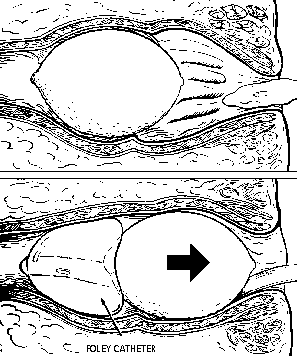6.12 Rectal Foreign Body
agk’s Library of Common Simple Emergencies
Presentation
An object is generally inserted by the patient or a partner for sexual stimulation; then it causes pain or bleeding or becomes irretrievable. There may be rectal or lower abdominal pain, obstipation or acute urinary retention. Sometimes the patient will not volunteer that any object has been inserted, or give outlandish explanations such as having sat or fallen onto the object. When interviewed privately, however, the patient will usually give an accurate accounting of the foreign body.
What to do:
- Perform an abdominal and rectal exam. If there are signs of peritoneal inflammation, such as rebound tenderness or pain with movement, a perforation of the bowel should be suspected, and you should start appropriate intravenous lines, draw blood for laboratory analysis, obtain flat and upright abdominal x rays to look for free air, notify surgical consultants and administer intravenous antibiotics.
- If there are no signs of perforation, still obtain flat and upright abdominal films to help define the nature, size, and number of foreign objects (as well as to reveal unsuspected free air).
- Sedate the patient with intravenous benzodiazepines and narcotics to help in the removal of the foreign body. Place the patient on his side in the Sims position. If anal discomfort persists, instill lidocaine jelly for mucosal anesthesia or locally infiltrate 1% lidocaine with epinephrine. The method of removal must be individualized depending on the size, shape, consistency and fragility of the object.
- When the object can be reached by the examining finger and it is of a nature that will allow it to be grasped, a lax anal sphincter may allow you slowly to insert as much of your gloved hand as possible to grab the object and gradually extricate it. Perforate fruit with your fingertips.
- If you are unable to pull out the foreign body with your hand, there are a number of techniques that can be used to get a purchase on the object and break the vacuum behind it:
- Slide a large Foley catheter with a 30cc balloon past the object, inflate the balloon, and apply traction to the catheter. (This can be used in conjunction with any of the other techniques.) Two catheters may occasionally be needed and air can be instilled through the lumen of the catheter.
- Under direct visualization with an anoscope or vaginal speculum, you can attempt to grasp the object with a tenaculum, sponge forcep, Kelly clamp or tonsil snare.
- An open object, like a jar or bottle, can be filled with wet plaster, into which a tongue blade can be inserted like a popsickle stick. When the plaster hardens, traction can be applied to the tongue blade.
- Forceps or soup spoons can be used to “deliver” a round object.
- With an object that is too high to reach, the patient can be admitted and sedated for removal the next day.
- When the object cannot be removed due to patient discomfort or sphincter tightness, then removal must be accomplished in the OR under spinal or general anesthesia.
- When blood is present in the rectum or the object is capable of doing harm to the bowel, then sigmoidoscopy should be performed after removal of the foreign body. When pain persists or there is any lingering suspicion of a bowel perfortion, keep the patient for observation.
What not to do:
- Do not pressure the patient into giving you an accurate story. He may be embarrassed and intimidation will not help.
- Do not push the object higher into the colon while attempting to remove it.
- Do not blindly grab for an object with a tenaculum or other such device. This can itself lead to a perforation.
- Do not attempt to remove sharp, jagged objects such as broken glass via the rectum. These should only be removed under anesthesia in the OR.
- Do not send a patient who is having continued pain home. Admit him and observe for peritoneal signs, increased pain, fever, and a rising white count.
Discussion
Most rectal foreign bodies (vibrators, dildos, broom handles, bottles, lightbulbs, balls, fruits, and vegetables) can be removed safely in the emergency department. Some practitioners quite reasonably forego x rays prior to manipulation if the patient is free of pain and fever. The famous gerbil is urban folklore. Consider recommending sexual or psychological counselling.
References:
- Couch CH, Tan EGC, Watt AG: Rectal foreign bodies. Med J Aust 1986;144:512-515.
Illustrations


-----------------------------------------------------
from Buttaravoli & Stair: COMMON SIMPLE EMERGENCIES ©
Longwood Information LLC 4822 Quebec St NW Washington DC 20016-3229
1.202.237.0971 fax 1.202.244.8393 electra@clark.net
-----------------------------------------------------


